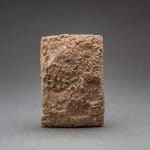Cuneiform Tablet, 2032 BCE
Clay
2 x 2.99
LSO.29
Clay Tablet, with 10 lines of Sumerian Cuneiform writing 2+ Lines on Revers The obverse of this tablet is quite well preserved but the reverse is very damaged, with salt...
Clay Tablet, with 10 lines of Sumerian Cuneiform writing 2+ Lines on Revers The obverse of this tablet is quite well preserved but the reverse is very damaged, with salt crystals adhering to broken surfaces. However, the content is clear: it is an administrative document from the period of the Third Dynasty of Ur, dated (in a damaged year name) to the 6th year of Shu-Sin, fourth king of the dynasty, c. 2032 BC. It is a record (on the obverse) of the remuneration of a particular serf. Some of the terms are not yet understood, but the general content is clear. Translation: 60 sila of barley, 4 minas of wool: Adallal………
Mr Ni-etaga, son of Ilum-bani, at the command of Ilum-ban Total: 1 serf: 60 sila of barley, 4 minas of woo The barley: 60 sila, for one mont The clothing: 4 minas for 1 yea
Provided and taken. (break) [Year: Ibbi-Sin, king of Ur, erected a] magnificent [stele] for [the gods] Enlil and Ninlil. ***
A sila was a measure of capacity, about .85 of a litre. A mina was a weight, about 500 grams. Thus, with a month of about 30 days, a serf received nearly 2 litres of barley a day, but that had to supply his whole family. A serf was tied to his job and could not negotiate his pay and conditions.
Mr Ni-etaga, son of Ilum-bani, at the command of Ilum-ban Total: 1 serf: 60 sila of barley, 4 minas of woo The barley: 60 sila, for one mont The clothing: 4 minas for 1 yea
Provided and taken. (break) [Year: Ibbi-Sin, king of Ur, erected a] magnificent [stele] for [the gods] Enlil and Ninlil. ***
A sila was a measure of capacity, about .85 of a litre. A mina was a weight, about 500 grams. Thus, with a month of about 30 days, a serf received nearly 2 litres of barley a day, but that had to supply his whole family. A serf was tied to his job and could not negotiate his pay and conditions.



